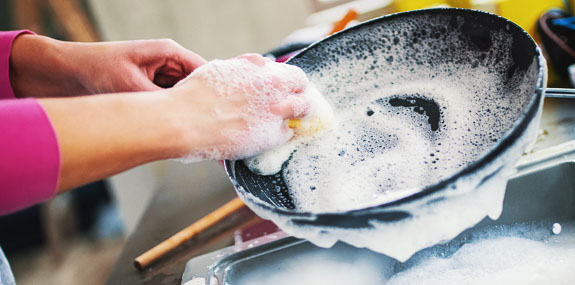
Date
May 8, 2019
Author
When there’s a man in the house, U.S. mothers sleep less and spend more time on tasks like cooking, laundry, and cleaning.
WASHINGTON, D.C., May 8, 2019 – As families across the country prepare to celebrate Mother’s Day this weekend, research funded by the Eunice Kennedy Shriver National Institute of Child Health and Human Development suggests that mothers with a husband or live-in male partner sleep less and do more housework than single mothers, despite having someone to share the load for undone housework.
Even when mom is the sole breadwinner, she doesn’t get a break from housework on her days off, doing three times as much cooking, cleaning, and laundry compared to what sole breadwinner fathers do on their days off, according to a related study.
“The idea that a mother does more housework when she has a partner or spouse may sound counterintuitive, but it’s the reality in most American households,” said demographer Linda Jacobsen, vice president of U.S. Programs at Population Reference Bureau (PRB), which announced the findings just in time for Mother’s Day. “What we don’t know is why mothers feel compelled to do more housework when there’s a man in the house.”
According to the study, “Marital Status and Mothers’ Time Use,” both single mothers and partnered mothers spend roughly the same amount of time looking after their children. But married mothers are more likely to sacrifice their own leisure time and sleep to do unpaid housework as compared with single and divorced mothers. Researchers hypothesize that it may be tied to social expectations for women with families.
Hard Work Is a Mother—A Mother’s Day Salute
“Married women may feel that to be a good wife, they must prioritize housework and child care ahead of their own leisure and sleep,” said Joanna Pepin of the University of Texas at Austin, who coauthored the study. “These expectations likely stem from society’s collective assumptions of what it means to be a wife and mother.”
The report, “Signs of Change? At-Home and Breadwinner Parents’ Housework and Child-Care Time,” shows that on an average work day, sole breadwinner mothers spend about an hour on tasks like cooking and cleaning while sole breadwinner fathers spend only about 10 minutes.
“When the at-home parent is the mother, there’s a clear expectation that she’ll be in charge of the family’s domestic life,” said study coauthor Noelle Chesley of University of Wisconsin–Milwaukee. “That’s not necessarily the case when the at-home parent is the father.”
The researchers noted that while more and more men are staying at home and looking after the children, fathers may not feel the same social pressure to provide the family with home-cooked meals or clean the messy house as frequently. “Women feel socially accountable for the appearance of the household,” said study coauthor Sarah Flood of the University of Minnesota–Twin Cities.
Prior studies have compared time spent on housework between men and women, but this research is the first that focuses on single versus partnered women, and married couples with male versus female sole breadwinners.
“These studies make it clear that moms living with men do more daily household chores than single moms,” said Jacobsen. “Even if married moms are the sole breadwinners, when they come home they still do a significant share of the housework on top of their paid jobs—the so-called second shift.”
The study on single versus partnered women housework was coauthored by Pepin, Liana Sayer of the University of Maryland, and Lynne Casper of the University of Southern California. Researchers examined 24-hour time-use diaries from participants in the U.S. Bureau of Labor Statistics’ American Time Use Survey (ATUS) between 2003 to 2012, with a focus on white, black, and Hispanic mothers ages 18 to 54 with at least one child under age 13 living with them. Their analysis considers weekday and weekend schedules, and other differences such as employment, education, age of children, and the presence of other extended family members in the household.
The study comparing married couples with male versus female sole breadwinners uses the same ATUS data and was conducted by Flood and Chesley. Their analysis controlled for a variety of characteristics including age, education, race, unemployment, income, retirement, disability, and the number and ages of children in the household.
Contact: Leslie Aun laun@prb.org
About Population Reference Bureau (PRB)
PRB informs people around the world about population, health, and the environment, and empowers them to use that information to advance the well-being of current and future generations.

 ">
">




